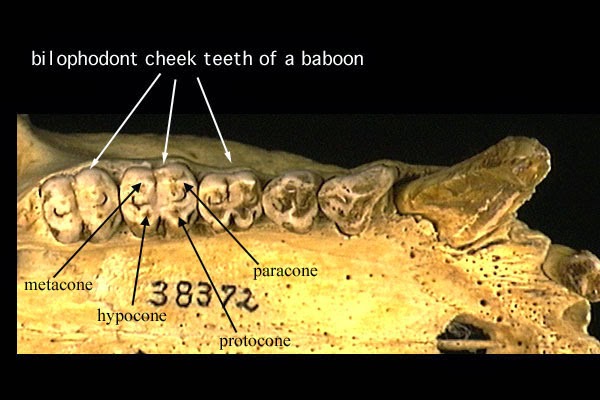Dention is one of the most important characters in Mammals when we talking about identification, special molars and premolars. Molars are the porteriors teeth, whit differents shapes and sizes and the function of crashing food. Premolars are before molar, and generally but not always are more small than molars, their functions is help canines to slice food and help molars to crush food. Here I will show all molars types, their descriptions and a kind of dicotomic key for identification.
Tribosphenic = Is the most primitive molar, the upper molar have a triangle shape with 3 cuspids: The Metacone, Paracone and Protocone. Actually are two class of Tribosphenic molar: Zalambdodont and Dilambdodont.
Zalambdodont = V shape molar or Lambda shape molar. In the large cuspid, on the lingual side are the Paracone ( The Metacone generaly are fused with the Paracone). From the Paracone runs a crest called Ectoloph to a lingual edge called Stylar Shelf. Generaly the Protocone is absent. This type of morlar is present in Solenodons (Soricomorpha) and Golde Moles (Chrysochloridae).
Dilambdodont = W shape molar or Double Lambda shape molar. Also present a ectoloph who forms a W, they conect the Metacone and Paracone whit other three minor cuspids, and the Protocone is out from the ectoloph. This type is common in insectivores animals like Shrews (Soricidae), Moles (Talpidae) and Bats (Vespertilionidae e.g.).
Quadrate = From the Tribosphenic tooth a fourth cuspid emerged and create the Quadrate molar, that cuspid is called Hypocone. Is the most common and varied tooth.
Hypsodont = This molar have such a very large coronoid, like 10 times larger than root. This is present in animals who are exposed to abrasive substances and a constant wear in alimentation like Herbivores like Horse, Cows, Rodents.
Brachydont = Is the opposite of a Hypsodont molar. This is present in many mammals like Primates, Racoons (Procionidae), Bears (Ursidae), Pig (Suidae) and other omnivores.
Lophodont = In this molar all cuspid are conected by a crest called loph, makes really difficult differenciate the cuspid, in some animals the molar looks like just one big big because the loph. This is present in Elephants (Elephantidae), Manatees (Trichechidae), Tapirs (Perissodactyla) and some Rodents.
Selenodont = Also have a loph, but unlike Lophodont, the cuspids are more notorious and the loph is more small. This is present in Deers (Cervidae), Cows (Bovidae) and Horses (Equidae).
Bilophodont = As its name says, have two loph who conect two cones, tranversal or horizontaly, and also the cuspid are notables. This is present in some Primates like Babbon and other Cercopithecids (Cercopithecidae), and some Marsupials.
Bunodont = Wihtout lophs, with notable rounde and small cuspids. Some time the Paracone is absent and its replace by the Entoconuloid. This is present in omnivorous like Primates, Bears, Racoons, Pigs.
Secodont = Is premolar modification, Its a bladelike premolar present in some herbivores.
Carnassial = Is a modification in the 4th upper premolar and 1st lower molar, usually but not always in carnivores. The teeht are elarged and blade like, and is used for slicing ahd chopping.
Dictomic key for
molar tooth identification.
1. Triangular shape.............................................................................................2
1'.Quadrate
shape................................................................................................4
3. Ectoloph
present with a V
shape...........................................Zalambdodont
3'.Ectoloph
present with a W
shape............................................Dilamdodont
4. Present a very
large coroid, 10 times more than
root.......(Hypsodont) 5
4'.Unlike
Hypsodont. Root and coronoid similars in
size....(Brachydont) 6
5. Present a
large, cointouos, very compresed loph. Molars looks like just one
tooth......................................................................................Lophodont
5'.Present a
small loph. Cuspids
notables.....................................Selenodont
6. Present 2
lophs, crossing horizontal or
transversal.............Bilophodont
6'.Wihtout
lophs..................................................................................................7
7.Cuspid smalls
and rounded, a notorious quadrate
shape..........Bunodont
7'.Tooth
bladelike
cuspids.................................................................................8
8. Small
bladelike
cuspids...................................................................Secodont
8'.4th premolar
and 1st molar with large bladelike
cuspids.....Carnassials
Bibliography.
http://www.savalli.us/BIO370/Anatomy/8.MammalTeethLabel.html http://animaldiversity.org/collections/mammal_anatomy/tooth_diversity/
http://ib.berkeley.edu/courses/ib173/lectures/lecture4/lecture4.html
http://www.vivo.colostate.edu/hbooks/pathphys/digestion/pregastric/dentalanat.html
http://animaldiversity.org/collections/mammal_anatomy/tooth_diversity/
http://news.sciencemag.org/2001/01/tooth-theory-revises-mammal-history
http://www.vivo.colostate.edu/hbooks/pathphys/digestion/pregastric/dentalanat.html
http://animaldiversity.org/collections/mammal_anatomy/tooth_diversity/
http://news.sciencemag.org/2001/01/tooth-theory-revises-mammal-history
http://en.wikipedia.org/wiki/Molar_%28tooth%29















